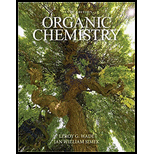
Concept explainers
(a)
Interpretation:
The given compound would give a positive Tollens test or not is to be predicted.
Concept introduction:
Tollens test is a laboratory test which is used to identify an
(b)
Interpretation:
The given compound would give a positive Tollens test or not is to be predicted.
Concept introduction:
Tollens test is a laboratory test which is used to identify an aldehyde and a ketone. It is also called as silver mirror test. In this test, Tollens reagent is used for the oxidation of aldehyde, whereas ketone does not give this test. Thus, the reaction of aldehyde with Tollens reagent gives a positive Tollens test.
(c)
Interpretation:
The given compound would give a positive Tollens test or not is to be predicted.
Concept introduction:
Tollens test is a laboratory test which is used to identify an aldehyde and a ketone. It is also called as silver mirror test. In this test, Tollens reagent is used for the oxidation of aldehyde, whereas ketone does not give this test. Thus, the reaction of aldehyde with Tollens reagent gives a positive Tollens test.
(d)
Interpretation:
The given compound would give a positive Tollens test or not is to be predicted.
Concept introduction:
Tollens test is a laboratory test which is used to identify an aldehyde and a ketone. It is also called as silver mirror test. In this test, Tollens reagent is used for the oxidation of aldehyde, whereas ketone does not give this test. Thus, the reaction of aldehyde with Tollens reagent gives a positive Tollens test.
(e)
Interpretation:
The given compound would give a positive Tollens test or not is to be predicted.
Concept introduction:
Tollens test is a laboratory test which is used to identify an aldehyde and a ketone. It is also called as silver mirror test. In this test, Tollens reagent is used for the oxidation of aldehyde, whereas ketone does not give this test. Thus, the reaction of aldehyde with Tollens reagent gives a positive Tollens test.
(f)
Interpretation:
The given compound would give a positive Tollens test or not is to be predicted.
Concept introduction:
Tollens test is a laboratory test which is used to identify an aldehyde and a ketone. It is also called as silver mirror test. In this test, Tollens reagent is used for the oxidation of aldehyde, whereas ketone does not give this test. Thus, the reaction of aldehyde with Tollens reagent gives a positive Tollens test.
Want to see the full answer?
Check out a sample textbook solution
Chapter 18 Solutions
ORGANIC CHEMISTRY
- Draw the products of each acid–base reaction.arrow_forwardErythronolide B is the biological precursor of erythromycin, a broad-spectrum antibiotic. What functional group Erythronolide B does contain? a. b. H₂CH₂C C. H₂C 1 H₂C 2 3 4 O Amide d. Amine OH Erythronolide B Ketone Aldehyde a CH₂ b C d CH₂ OH JCH₂ 'OH OHarrow_forwardAmino acids such as glycine are the building blocks of large molecules called proteins that give structure to muscle, tendon, hair, and nails. a. Explain why glycine does not actually exist in the form with all atoms uncharged, but actually exists as a salt called a zwitterion. b. What product is formed when glycine is treated with concentrated HCl? c. What product is formed when glycine is treated with NaOH?arrow_forward
- 1. Complete the following reactions. a. b. C. N HIN 1. LiAlH4 2. H₂O* 1. NaAlH4 2. H₂O* 1. LiAlH4 2. H₂O*arrow_forward5 6 Is the compound E or Z? Attachments A. E B. Z Is this molecule E or Z. I Attachments 3-bromo-2-carboxaldehydo-3-fluorobut-2-enoic acid H₂N H₂N A. Z B. E HC HCH₂C C ECH₂C OH Br CH₂CH CH₂CH₂OHarrow_forward1. What are the characteristics of a positive tollens test for adehydes? What is the oxidizing agent in tollens solutions? 2. What is the characteristics of a positive Benedict's test for aldehydes? What is the oxidizing agent in Benedict's solution?arrow_forward
- are involved in the regulation of glucose metabolism and in control tissue swelling by the control of inflammation, while regulating cellular salt balance between Na+ and K+. a.glucocorticoids, mineralocorticoids b. mineralocorticoids, glucocorticoids c. androgen, estrogen d. estrogen, androgen Which of the following represents an aldonic acid? OH OH но, но OH но —н но Но HO HO H но но H H- -OH -OH H OH H FOH H- -OH- OH HO но HO. OH II III IV V Refer to the structures. Which of the following compounds will react with acetyl chloride to give an amide and ester, respectively? NH2 ÇOOH CH3 он CHO II II IV V The six groups of enzymes are the following: I. Oxidoreductases II. Transferases III. Hydrolases IV. Isomerases V. Lyases VI. Ligases Fill in the blanks: catalyze hydrolysis while catalyze bond formation.arrow_forwardQuestions 17 and 18arrow_forwardWhat are the products of the reaction between acetyl chloride and diethylamine? HCl and N,N-diethylacetamide Оа. o b. HCl and diethylamine chloride ос. HCl and N-ethylacetamide d. Diethylacetamide and acidarrow_forward
 Organic Chemistry: A Guided InquiryChemistryISBN:9780618974122Author:Andrei StraumanisPublisher:Cengage Learning
Organic Chemistry: A Guided InquiryChemistryISBN:9780618974122Author:Andrei StraumanisPublisher:Cengage Learning Introduction to General, Organic and BiochemistryChemistryISBN:9781285869759Author:Frederick A. Bettelheim, William H. Brown, Mary K. Campbell, Shawn O. Farrell, Omar TorresPublisher:Cengage Learning
Introduction to General, Organic and BiochemistryChemistryISBN:9781285869759Author:Frederick A. Bettelheim, William H. Brown, Mary K. Campbell, Shawn O. Farrell, Omar TorresPublisher:Cengage Learning Organic ChemistryChemistryISBN:9781305580350Author:William H. Brown, Brent L. Iverson, Eric Anslyn, Christopher S. FootePublisher:Cengage Learning
Organic ChemistryChemistryISBN:9781305580350Author:William H. Brown, Brent L. Iverson, Eric Anslyn, Christopher S. FootePublisher:Cengage Learning


